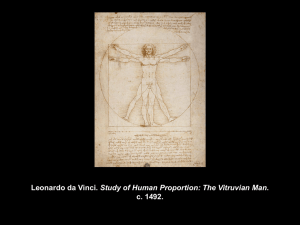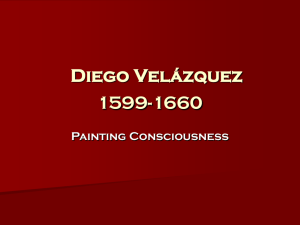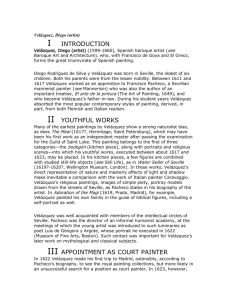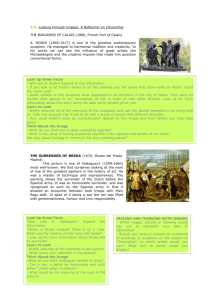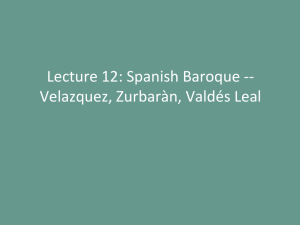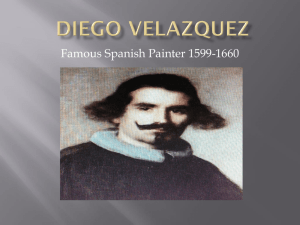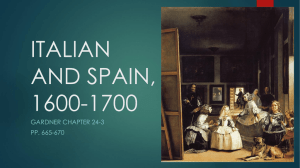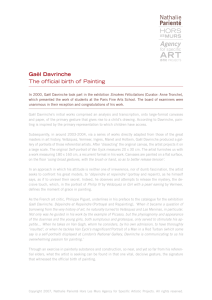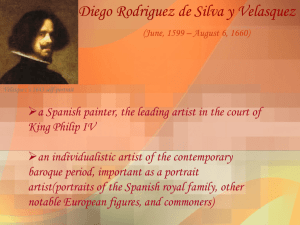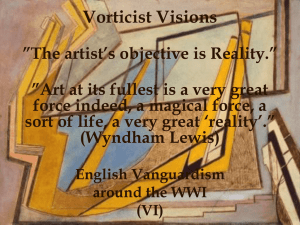El arte - Marion City Schools
advertisement
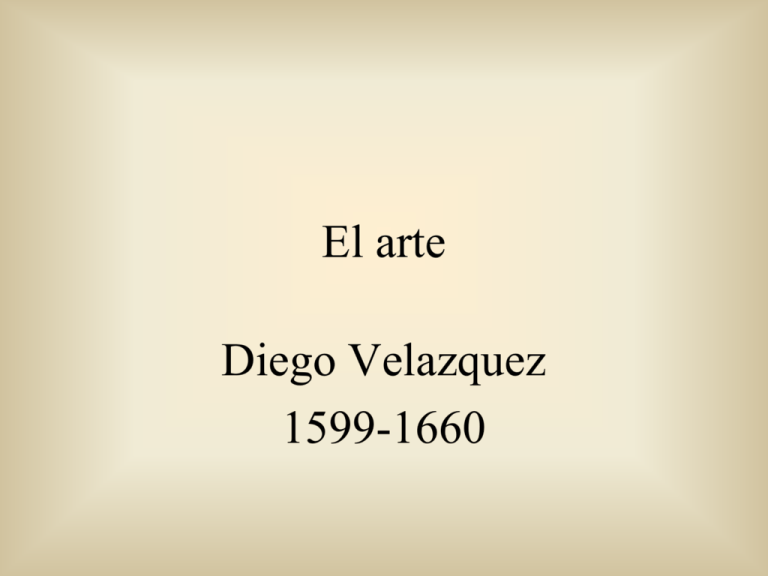
El arte Diego Velazquez 1599-1660 • Diego Rodríguez de Silva y Velázquez was a Spanish painter who is considered to have been the country's greatest baroque artist. He, with Francisco de Goya and El Greco, forms the great triumvirate of Spanish painting. • Velázquez was born in Sevilla on June 6, 1599, the oldest of six children; both his parents were from the minor nobility. • Between 1611 and 1617 the young Velázquez worked as an apprentice to Francisco Pacheco, a Sevillian Mannerist painter who was also the author of an important treatise. (politics) • During his student years Velázquez absorbed the most popular contemporaneous styles of painting, derived, in part, from both Flemish and Italian realism. • Youthful Works • Many of his earliest paintings show a strong naturalist bias, as does The Breakfast (circa 1618, Hermitage, Saint Petersburg), which may have been his first work as an independent master after passing the examination of the Guild of Saint Luke. • First three categories—the bodegón, or kitchen piece, portraits, and religious scenes • In his kitchen pieces, a few figures are combined with studied still-life objects, as in Water Seller of Seville (circa 1619-20, Wellington Museum, London). • The masterly effects of light and shadow, as well as the direct observation of nature, make inevitable a comparison with the work of the Italian painter Caravaggio. Velázquez's religious paintings, images of simple piety, portray models drawn from the streets of Seville, as Pacheco states in his biography of Velázquez. • In Adoration of the Magi (1619, Museo del Prado, Madrid), for example, the artist painted his own family in the guise of biblical figures, including a self-portrait as well. • Velázquez later worked on mythological and classical subjects. • Appointment as Court Painter • In 1622 Velázquez made his first trip to Madrid, ostensibly to see (as Pacheco tells it) the royal painting collections, but more likely in an unsuccessful search for a position as court painter. • Mythological subjects would at times occupy his attention, as in Bacchus or The Drinkers (1628-29, Museo del Prado). This scene of revelry in an open field, picturing the god of wine drinking with ruffian types, testifies to the artist's continued interest in realism. • Velazquez goes to Italy • In the course of his journey he closely studied both the art of the Renaissance and contemporaneous painting. Several of the works executed during his travels attest to his absorption of these styles; a notable example is Joseph and His Brothers (1630, El Escorial, near Madrid), which combines a Michelangelesque sculptural quality with the chiaroscuro (light-and-shadow techniques) of such Italian masters as Guercino and Giovanni Lanfranco. • On his return to Madrid, Velázquez resumed his duties as court portraitist. • The second major series of paintings of the 1630s by Velázquez was a group of hunting portraits of the royal family for the Torre de la Parada, a hunting lodge near Madrid. • During the last 20 years of his life Velázquez's work as court official and architect assumed prime importance. He was responsible for the decoration of many new rooms in the royal palaces. • Velazquez’s works were important even past his death. • His work influenced the Spanish Painter, Francisco Goya. Autorretrato La coronación de la Virgen Coronation of the Virgen. Don Sebastian de Mora La infanta Margarita Felipe IV en armadura Felipe 4th in armor Las Meninas Ladys in waiting. (His most famous work) Padre Inocente X La adoración del magi Adoration of the Magi La forja de Vulcan The forge of Vulcan La rendición de Breda Surrender of Breda El vendedor de agua de Sevilla Waterseller of Sevilla.
